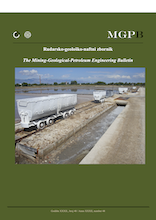Investigating a comprehensive model for evaluating occupational and environmental risks of dimensional stone mining
DOI:
https://doi.org/10.17794/rgn.2020.1.8Keywords:
Risk assessment, Dimensional stone, Fuzzy-AHP, Risk Breakdown Structure, PROMETHEEAbstract
One of the most hazardous fields of engineering is mining operations and accordingly, it requires extra consideration on risk evaluation. Decorative stone quarrying is one of the main branches of the mining industry in Iran. Currently, Iran, China and Italy are known as the three main producers of decorative stones in the world. Subsequently, risk assessment is one of the main steps of quarrying organization. One of the main steps of risk assessment is Risk Breakdown Structure (RBS). In order to achieve this goal, a comprehensive structure of dimensional stone quarrying is modelled in this re- search and divided into 17 main levels. One of the most useful procedures of risk ranking is Multi attribute decision- making methods which state that they have numerous affecting parameters. In the next step of this study, the main hazards of main decorative stone quarrying are assessed by implementing the ‘Preference Ranking Organization Method for Enrichment Evaluation’ (PROMETHEE) technique. As a final point, Economical, Management, and Schedule risks are determined as the most intimidating hazards in this field.
Downloads
Published
How to Cite
Issue
Section
License
Copyright (c) 2020 authors and journal

This work is licensed under a Creative Commons Attribution 4.0 International License.
Creative Commons-BY
Authors who publish with this journal agree to the following terms:
In agreeing this form, you certify that:
- You read the ethical codex of the RGN zbornik available at journal web.
- You submitted work is your original work, and has not previously been published and does not include any form of plagiarism.
- You own copyright in the submitted work, and are therefore permitted to assign the licence to publish to RGN zbornik.
- Your submitted work contains no violation of any existing copyright or other third party right or any material of an obscene, libellous or otherwise unlawful nature.
- You have obtained permission for and acknowledged the source of any illustrations, diagrams or other material included in the work of which you are not the copyright owner.
- You have taken due care to ensure the accuracy of the work, and that, to the best of your knowledge, there are no false statements made within it.
- All co-authors of this submitted work are aware of, and in agreement with, the terms of this licence and that the submitted manuscript has been approved by these authors.
Publication licence
You retain copyright in your submitted work, according to journal license policy (CC-BY). By signing this form you agree that RGN zbornik may publish it under the publication licence. In summary the licence allows the following:
Anyone is free:
- To copy, distribute, display, and perform the work.
- To make derivative works.
Under the following conditions:
- The original author must always be given credit.
- The work may not be used for commercial purposes.
- If the work is altered, transformed, or built upon, the resulting work may only be distributed under a licence identical to this one.
Exceptions to the licence
In addition to publishing the work printed under the above licence, RGN zbornik will also enable the work to be visible online.
The journal editorial can change the licence rules anytime but it cannot retroactively restrict author(s) rights.


